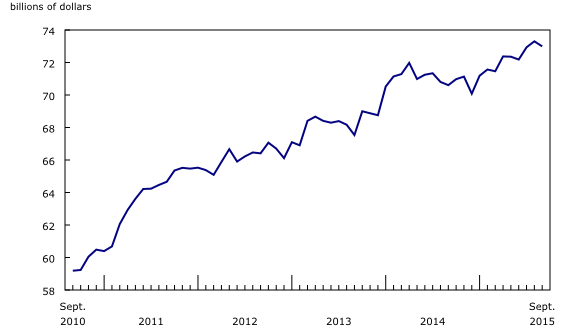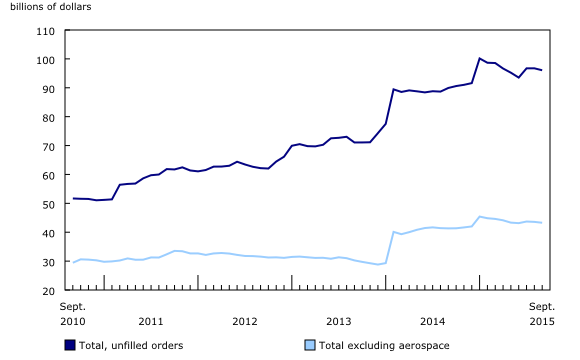Monthly Survey of Manufacturing, September 2015
Archived Content
Information identified as archived is provided for reference, research or recordkeeping purposes. It is not subject to the Government of Canada Web Standards and has not been altered or updated since it was archived. Please "contact us" to request a format other than those available.
Released: 2015-11-16
Manufacturing sales declined 1.5% to $51.1 billion in September, following a 0.6% decrease in August. Lower sales in the motor vehicle assembly and the petroleum and coal product industries were responsible for the decline.
Sales were down in 13 of 21 industries, representing 78.6% of Canadian manufacturing.
Constant dollar manufacturing sales were down 1.6%, indicating that the volume of goods sold was lower in September.
Lower sales of motor vehicles and petroleum and coal products
In the motor vehicle assembly industry, sales fell 10.3% to $5.0 billion in September following four months of gains. In August, sales had reached $5.6 billion, their highest level since March 2007. The decline in September mostly reflected lower numbers of vehicles produced. In contrast to the motor vehicle assembly industry, sales in the motor vehicle parts industry edged down 0.1% in September.
Sales in the petroleum and coal product industry were down 7.1% to $4.8 billion in September, the fourth consecutive decline. The decrease largely reflected partial shutdowns at a number of refineries during the month for maintenance work. Although refineries often shut down for part of September, this year the shutdowns were more extensive than usual. Prices for refined petroleum products declined 4.0%, according to the Industrial Product Price Index.
Higher sales in the machinery and primary metal industries offset some of the declines. In the machinery industry, sales rose 9.6% to $2.9 billion as a result of widespread gains. Primary metal sales were up 4.3%, also as a result of numerous gains.
Sales decline in Ontario
Sales decreased in four provinces in September, with the largest decline in Ontario.
In Ontario, sales were down 2.5% to $24.4 billion. The decrease stemmed mostly from a 10.1% drop in motor vehicle assembly sales and a 7.1% decline in the petroleum and coal product industry. These decreases were partly offset by a 13.1% advance in machinery sales.
Sales in Quebec declined 1.0% to $12.0 billion in September, the third consecutive monthly decrease. The petroleum and coal product industry posted the largest decline. Sales of aerospace product and parts, chemicals and fabricated metal products also fell. Lower sales in these industries were partly offset by a 10.2% gain in the primary metal industry.
Alberta manufacturing sales decreased 1.4% to $5.7 billion in September, the third consecutive monthly decline. The decrease was due to a 10.6% drop in petroleum and coal product sales. Higher sales (+13.0%) in the machinery industry offset some of the decrease.
Inventories decrease
Manufacturing inventories were down 0.4% to $73.0 billion in September. Inventory levels decreased 4.2% in the petroleum and coal product industry and 2.6% in the primary metal industry. Inventories of machinery (-2.0%) also declined. Inventory levels rose in the aerospace product and parts (+1.4%) and motor vehicle assembly (+5.7%) industries.
The inventory-to-sales ratio rose from 1.41 in August to 1.43 in September. The inventory-to-sales ratio measures the time, in months, that would be required to exhaust inventories if sales were to remain at their current level.
Unfilled orders decline
Unfilled orders decreased 0.7% to $96.1 billion in September, as a result of a 0.9% decline in the transportation equipment industry.
Aerospace unfilled orders decreased 0.7% to $52.8 billion, despite an increase in the value of the US dollar relative to the Canadian dollar. A substantial portion of aerospace unfilled orders are held in US dollars. Unfilled orders were also down in the other transportation equipment industry and the railroad rolling stock industry.
New orders decreased 2.8%, mostly as a result of declines in the transportation equipment industry.
Note to readers
Unadjusted data for sales of goods manufactured, inventories and orders have been revised back to January 2009, while seasonally adjusted data have been revised back to January 2007. These important data changes are the result of the following:
1) Data comparisons between the Monthly Survey of Manufacturing (MSM) and the 2013 Annual Survey of Manufactures and Logging. This is an annual process to ensure that the data received for the largest units in both the annual and monthly surveys are consistent.
2) New information received from respondents and the availability of more up-to-date administrative data.
3) Updates to X-12-ARIMA seasonal adjustment models. As in past years, trading-day weights and analysis of trends, levels and moving averages have been updated and revised. This ensures that the seasonally adjusted data accurately reflect the latest developments in manufacturing.
4) Revisions to the constant dollar series back to January 2009.
5) Review of the MSM confidentiality pattern undertaken based on the revised data. Changes to the pattern were made for the years 2012 to 2015.
Monthly data in this release are seasonally adjusted and are expressed in current dollars unless otherwise specified. For more information on seasonal adjustment, see Seasonally adjusted data – Frequently asked questions.
For more information on the trend-cycles, see Trend-cycle estimates – Frequently asked questions.
Non-durable goods industries include food, beverage and tobacco products, textile mills, textile product mills, clothing, leather and allied products, paper, printing and related support activities, petroleum and coal products, chemicals as well as plastics and rubber products.
Durable goods industries include wood products, non-metallic mineral products, primary metal, fabricated metal products, machinery, computer and electronic products, electrical equipment, appliances and components, transportation equipment, furniture and related products and miscellaneous manufacturing.
Production-based industries
For the aerospace industry and shipbuilding industries, the value of production is used instead of sales of goods manufactured. This value is calculated by adjusting monthly sales of goods manufactured by the monthly change in inventories of goods in process and finished products manufactured. Production is used because of the extended period of time that it normally takes to manufacture products in those industries.
Unfilled orders are a stock of orders that will contribute to future sales assuming that the orders are not cancelled.
New orders are those received whether sold in the current month or not. New orders are measured as the sum of sales for the current month plus the change in unfilled orders from the previous month to the current month.
Manufacturers reporting in US dollars
Some Canadian manufacturers report sales, inventories and unfilled orders in US dollars. These data are then converted to Canadian dollars as part of the data production cycle.
For sales, based on the assumption that they occur throughout the month, the average monthly exchange rate for the reference month (noon spot rate) established by the Bank of Canada is used for the conversion. The monthly average exchange rate is available in CANSIM table 176-0064.
Inventories and unfilled orders are reported at the end of the reference period. For most respondents, the noon spot exchange rate on the last working day of the month is used for the conversion of these variables. However, some manufacturers choose to report their data as of a day other than the last day of the month. In these instances, the noon spot exchange rate on the day selected by the respondent is used. Because of exchange rate fluctuations, the noon spot exchange rate on the day selected by the respondent can differ from both the exchange rate on the last working day of the month and the monthly average exchange rate. Noon spot exchange rate data are available in CANSIM table 176-0067.
Real-time CANSIM tables
Real-time CANSIM tables 304-8014, 304-8015 and 377-8009 will be updated on November 25. For more information, consult the document Real-time CANSIM tables.
Next release
Data from the October Monthly Survey of Manufacturing will be released on December 15.
Contact information
For more information, contact us (toll-free 1-800-263-1136; 514-283-8300; STATCAN.infostats-infostats.STATCAN@canada.ca).
To enquire about the concepts, methods or data quality of this release, contact Jeff Paul (613-951-7328; jeff.paul@canada.ca) or Elizabeth Richards (613-863-4623; elizabeth.richards@canada.ca), Manufacturing and Wholesale Trade Division.
- Date modified:







